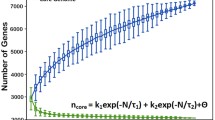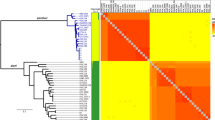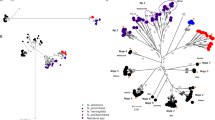Abstract
Neisseria, a genus from the beta-proteobacteria class, is of potential clinical importance. This genus contains both pathogenic and commensal strains. Gonorrhea and meningitis are two major diseases caused by pathogens belonging to this genus. With the increased use of antimicrobial agents against these pathogens they have evolved the antimicrobial resistance capacity making these diseases nearly untreatable. The set of anti-bacterial resistance genes (resistome) and genes associated with signal processing (secretomes) are crucial for the host-microbial interaction. With the virtue of whole-genome sequences and computational biology, it is now possible to study the genomic and proteomic riddles of Neisseria along with their comprehensive evolutionary and metabolic profiling. We have studied relative synonymous codon usage, amino acid usage, reverse ecology, comparative genomics, evolutionary analysis and pathogen-host (Neisseria-human) interaction through bioinformatics analysis. Our analysis revealed the co-evolution of Neisseria genomes with the human host. Moreover, the co-occurrence of Neisseria and humans has been supported through reverse ecology analysis. A differential pattern of the evolutionary rate of resistomes and secretomes was evident among the pathogenic and commensal strains. Comparative genomics supported the presence of virulent genes in both pathogenic and commensal strains of the select genus. Our analysis also indicated a transition from commensal to pathogenic Neisseria strains through the long run of evolution.






Similar content being viewed by others
Abbreviations
- AMR :
-
Anti-microbial resistance
- STD :
-
Sexually transmitted disease
- MLA :
-
Multi-locus alignment
- NJ :
-
Neighbor-joining
- KO :
-
KEGG ontology
- CUB :
-
Codon usage bias
- GC :
-
Total guanine and cytosine
- GC3 :
-
Total guanine and cytosine at third position of codons
- Fop :
-
Frequency of optimal codons
- tAI :
-
TRNA adaptation index
- Enc :
-
Effective number of codons
- CAI :
-
Codon adaptation index
- PEC :
-
Protein energy cost
- RSCU :
-
Relative synonymous codon usage
- PHX genes :
-
Potentially highly expressed genes
- PLX genes :
-
Potentially lowly expressed genes
References
Akashi H, Gojobori T (2002) Metabolic efficiency and amino acid composition in the proteomes of Escherichia coli and Bacillus subtilis. Proc Natl Acad Sci 99(6):3695–3700
Albenne C, Skov LK, Mirza O, Gajhede M, Feller G, d’Amico S, Remaud-Simeon M (2004) Molecular basis of the amylose-like polymer formation catalyzed by Neisseria polysaccharea amylosucrase. J Biol Chem 279(1):726–734
Al Mahmeed N, El Nekidy WS, Langah R, Nusair AR (2020) Meningitis as the initial manifestation of systemic lupus erythematosus. Idcases 21:e00904
Al Suwayyid BA, Rankine-Wilson L, Speers DJ, Wise MJ, Coombs GW, Kahler CM (2020) Meningococcal disease-associated prophage-like elements are present in Neisseria gonorrhoeae and some commensal Neisseria species. Genome Biol Evol 12(2):3938–3950
Amorós-Moya D, Bedhomme S, Hermann M, Bravo IG (2010) Evolution in regulatory regions rapidly compensates the cost of nonoptimal codon usage. Mol Biol Evol 27(9):2141–2151
Andersen BM, Steigerwalt AG, O’Connor SP, Hollis DG, Weyant RS, Weaver RE, Brenner DJ (1993) Neisseria weaveri sp. nov., formerly CDC group M-5, a gram-negative bacterium associated with dog bite wounds. J Clin Microbiol 31(9):2456–2466
Andersen BM, Weyant RS, Steigerwalt AG, Moss CW, Hollis DG, Weaver RE, Brenner DJ (1995) Characterization of Neisseria elongata subsp. glycolytica isolates obtained from human wound specimens and blood cultures. J Clin Microbiol 33(1):76–78
Batra V, Khararjian A, Wheat J, Zhang SX, Crain B, Baras A (2016) From suspected Creutzfeldt-Jakob disease to confirmed histoplasma meningitis. Case Rep. https://doi.org/10.1136/bcr-2016-214937
Bohlin J (2011) Genomic signatures in microbes—properties and applications. Sci World J 11:715–725
Bohlin J, Eldholm V, Pettersson JH, Brynildsrud O, Snipen L (2017) The nucleotide composition of microbial genomes indicates differential patterns of selection on core and accessory genomes. BMC Genomics 18(1):1–11
Botzman M, Margalit H (2011) Variation in global codon usage bias among prokaryotic organisms is associated with their lifestyles. Genome Biol 12(10):1–11
Butt AM, Nasrullah I, Qamar R, Tong Y (2016) Evolution of codon usage in Zika virus genomes is host and vector specific. Emerg Microbes Infect 5(1):1–14
Caini S, Gandini S, Dudas M, Bremer V, Severi E, Gherasim A (2014) Sexually transmitted infections and prostate cancer risk: a systematic review and meta-analysis. Cancer Epidemiol 38(4):329–338
Calder A, Menkiti CJ, Çağdaş A, Santos JL, Streich R, Wong A et al (2020) Virulence genes and previously unexplored gene clusters in four commensal Neisseria spp. isolated from the human throat expand the Neisserial gene repertoire. Microbial Genomics. https://doi.org/10.1099/mgen.0.000423
Carr R, Borenstein E (2012) NetSeed: a network-based reverse-ecology tool for calculating the metabolic interface of an organism with its environment. Bioinformatics 28(5):734–735
Chambers J (2008) Software for data analysis: programming with R. Springer Science & Business Media, Berlin
Clemence MEA, Maiden MCJ, Harrison OB (2018) Characterization of capsule genes in non-pathogenic Neisseria species. Microbial Genomics. https://doi.org/10.1099/mgen.0.000208
Cornejo-Granados F, Zatarain-Barrón ZL, Cantu-Robles VA, Mendoza-Vargas A, Molina-Romero C, Sánchez F et al (2017) Secretome prediction of two M. tuberculosis clinical isolates reveals their high antigenic density and potential drug targets. Front Microbiol 8:128
Ehrlich GD, Hiller NL, Hu FZ (2008) What makes pathogens pathogenic. Genome Biol 9(6):1–7
Elias J, Frosch M, Vogel U (2015) Neisseria. Manual Clin Microbiol. https://doi.org/10.1128/9781555817381.ch34
Garcia-Vallve S, Guzmán E, Montero MA, Romeu A (2003) HGT-DB: a database of putative horizontally transferred genes in prokaryotic complete genomes. Nucleic Acids Res 31(1):187–189
Garg A, Gupta D (2008) VirulentPred: a SVM based prediction method for virulent proteins in bacterial pathogens. BMC Bioinformatics 9(1):1–12
Grantham R, Gautier C, Gouy M, Mercier R, Pave A (1980) Codon catalog usage and the genome hypothesis. Nucleic Acids Res 8(1):197–197
Gris P, Vincke G, Delmez JP, Dierckx JP (1989) Neisseria sicca pneumonia and bronchiectasis. Eur Respir J 2(7):685–687
Hansman D (1978) Meningitis caused by Neisseria lactamica. N Engl J Med 299(9):491
Henderson JF, Paterson ARP (2014) Nucleotide metabolism: an introduction. Academic Press
Hershberg R, Petrov DA (2010) Evidence that mutation is universally biased towards AT in bacteria. PLoS Genet 6(9):e1001115
Heydecke A, Andersson B, Holmdahl T, Melhus Å (2013) Human wound infections caused by Neisseria animaloris and Neisseria zoodegmatis, former CDC Group EF-4a and EF-4b. Infect Ecol Epidemiol 3(1):20312
Hildebrand F, Meyer A, Eyre-Walker A (2010) Evidence of selection upon genomic GC-content in bacteria. PLoS Genet 6(9):e1001107
Huang L, Ma L, Fan K, Li Y, Xie L, Xia W et al (2014) Necrotizing pneumonia and empyema caused by Neisseria flavescens infection. J Thorac Dis 6(5):553
Hurst LD, Smith NG (1999) Do essential genes evolve slowly? Curr Biol 9(14):747–750
Jordan IK, Rogozin IB, Wolf YI, Koonin EV (2002) Essential genes are more evolutionarily conserved than are nonessential genes in bacteria. Genome Res 12(6):962–968
Kellogg DS Jr, Peacock WL Jr, Deacon WE, Brown L, Pirkle CI (1963) Neisseria gonorrhoeae I: virulence genetically linked to clonal variation. J Bacteriol 85(6):1274–1279
Kim EM, Seong CN (2018) Complete genome sequence of Neisseria sp. KEM232 isolated from a human smooth surface caries. Korean J Microbiol 54(1):81–83
Kumar S, Stecher G, Li M, Knyaz C, Tamura K (2018) MEGA X: molecular evolutionary genetics analysis across computing platforms. Mol Biol Evol 35(6):1547
Lawrence JG, Ochman H (1997) Amelioration of bacterial genomes: rates of change and exchange. J Mol Evol 44(4):383–397
Levy R, Borenstein E (2012) Reverse ecology: from systems to environments and back. Evolutionary systems biology. Springer, New York, pp 329–345
Lu QF, Cao DM, Su LL, Li SB, Ye GB, Zhu XY, Wang JP (2019) Genus-wide comparative genomics analysis of Neisseria to identify new genes associated with pathogenicity and niche adaptation of Neisseria pathogens. Int J Genomics. https://doi.org/10.1155/2019/6015730
Markowitz VM, Chen IMA, Palaniappan K, Chu K, Szeto E, Grechkin Y, Kyrpides NC (2012) IMG: the integrated microbial genomes database and comparative analysis system. Nucleic Acids Res 40(D1):D115–D122
McArthur AG, Waglechner N, Nizam F, Yan A, Azad MA, Baylay AJ, Wright GD (2013) The comprehensive antibiotic resistance database. Antimicrob Agents Chemother 57(7):3348–3357
McSheffrey GG, Gray-Owen SD (2015) Neisseria gonorrhoeae. Molecular medical microbiology. Academic Press, Cambridge, pp 1471–1485
Mechergui A, Achour W, Baaboura R, Ouertani H, Lakhal A, Torjemane L, Hassen AB (2014) Case report of bacteremia due to Neisseria mucosa. APMIS 122(4):359–361
Mustapha MM, Lemos APS, Griffith MP, Evans DR, Marx R, Coltro ES, Sacchi CT (2020) Two cases of newly characterized Neisseria species. Brazil Emerg Infect Dis 26(2):366
Nakamura Y, Itoh T, Matsuda H, Gojobori T (2004) Biased biological functions of horizontally transferred genes in prokaryotic genomes. Nat Genet 36(7):760–766
Nekrutenko A, Makova KD, Li WH (2002) The KA/KS ratio test for assessing the protein-coding potential of genomic regions: an empirical and simulation study. Genome Res 12(1):198–202
Piñero J, Bravo À, Queralt-Rosinach N, Gutiérrez-Sacristán A, Deu-Pons J, Centeno E, Furlong LI (2016) DisGeNET: a comprehensive platform integrating information on human disease-associated genes and variants. Nucleic Acids Res. https://doi.org/10.1093/nar/gkw943
Rao VS, Srinivas K, Sujini GN, Kumar GN (2014) Protein-protein interaction detection: methods and analysis. Int J Proteomics. https://doi.org/10.1155/2014/147648
Reis MD, Savva R, Wernisch L (2004) Solving the riddle of codon usage preferences: a test for translational selection. Nucleic Acids Res 32(17):5036–5044
Rouphael NG, Stephens DS (2012) Neisseria meningitidis: biology, microbiology, and epidemiology. Neisseria Meningitidis. https://doi.org/10.1007/978-1-61779-346-2_1
Roy A, Sen A, Chakrobarty S, Sarkar I (2018) Comprehensive profiling of functional attributes, virulence potential and evolutionary dynamics in mycobacterial secretomes. World J Microbiol Biotechnol 34(1):1–19
Safton S, Cooper G, Harrison M, Wright L, Walsh P (1999) Neisseria canis infection: a case report. Commun Dis Intell 23(8):221
Saha MS, Pal S, Sarkar I, Roy A, Mohapatra PKD, Sen A (2019) Comparative genomics of Mycobacterium reveals evolutionary trends of M. avium complex. Genomics 111(3):426–435
Schmidt H, Hensel M (2004) Pathogenicity islands in bacterial pathogenesis. Clin Microbiol Rev 17(1):14–56
Smoot ME, Ono K, Ruscheinski J, Wang PL, Ideker T (2011) Cytoscape 2.8: new features for data integration and network visualization. Bioinformatics 27(3):431–432
Snel B, Lehmann G, Bork P, Huynen MA (2000) STRING: a web-server to retrieve and display the repeatedly occurring neighbourhood of a gene. Nucleic Acids Res 28(18):3442–3444
Snyder LA, Saunders NJ (2006) The majority of genes in the pathogenic Neisseria species are present in non-pathogenic Neisseria lactamica, including those designated as’ virulence genes’. BMC Genomics 7(1):1–11
Soncin F, Parast MM (2020) Role of Hippo signaling pathway in early placental development. Proc Natl Acad Sci 117(34):20354–20356
Stephens DS, Greenwood B, Brandtzaeg P (2007) Epidemic meningitis, meningococcaemia, and Neisseria meningitidis. The Lancet 369(9580):2196–2210
Taormina G, Campos J, Sweitzer J, Retchless AC, Lunquest K, McNamara LA et al (2021) β-lactamase–producing, ciprofloxacin-resistant Neisseria meningitidis isolated from a 5-month-old boy in the United States. J Pediatric Infect Dis Soc 10(3):379–381
Thompson JD, Gibson TJ, Higgins DG (2003) Multiple sequence alignment using ClustalW and ClustalX. Curr Protoc Bioinformatics 1:2–3
Unemo M, Shafer WM (2014) Antimicrobial resistance in Neisseria gonorrhoeae in the 21st century: past, evolution, and future. Clin Microbiol Rev 27(3):587–613
Vesth T, Lagesen K, Acar Ö, Ussery D (2013) CMG-biotools, a free workbench for basic comparative microbial genomics. PLoS ONE 8(4):e6012
Volokhov DV, Amselle M, Bodeis-Jones S, Delmonte P, Zhang S, Davidson MK et al (2018) Neisseria zalophi sp. Nov., isolated from oral cavity of California sea lions (Zalophus californianus). Arch Microbiol 200(5):819–828
Wilson AC, Carlson SS, White TJ (1977) Biochemical evolution. Annu Rev Biochem 46(1):573–639
Xia X, Xie Z (2001) DAMBE: software package for data analysis in molecular biology and evolution. J Hered 92(4):371–373
Yakovchuk P, Protozanova E, Frank-Kamenetskii MD (2006) Base-stacking and base-pairing contributions into thermal stability of the DNA double helix. Nucleic Acids Res 34(2):564–574
Yang Z (1997) PAML: a program package for phylogenetic analysis by maximum likelihood. Comput Appl Biosci 13(5):555–556
Yang F, Yan J, van der Veen S (2020) Antibiotic resistance and treatment options for multidrug-resistant gonorrhea. Infect Microbes Dis. https://doi.org/10.1097/IM9.0000000000000024
Funding
The authors have not disclosed any funding.
Author information
Authors and Affiliations
Contributions
RPS, IS, GDV and SSR conceived the idea. IS and PD curated the data and performed all analyses. RPS, IS, PD, SSR, GDV wrote the manuscript. All authors have agreed to the final version of the manuscript.
Corresponding author
Ethics declarations
Conflict of interest
The authors declare no conflict of interest.
Additional information
Publisher's Note
Springer Nature remains neutral with regard to jurisdictional claims in published maps and institutional affiliations.
Supplementary Information
Below is the link to the electronic supplementary material.
11274_2022_3338_MOESM1_ESM.xlsx
Supplementary file1 (XLSX 227 kb)— KEGG ID of metabolic compounds shared between the selected 21 Neisseria species and human host are given under the heading ‘Edge list’. ‘Seed set’ are those which are to be taken exogenously and confidence level is the probability of a seed. Based upon this interaction, competition and complementation index were calculated and a metabolic network was generated.
11274_2022_3338_MOESM2_ESM.xlsx
Supplementary file2 (XLSX 11 kb)—List of human proteins associated with Gonorrhoea as obtained from DisGenet server. DSI_g of more than 0.7 was used as a cut-off.
11274_2022_3338_MOESM3_ESM.xlsx
Supplementary file3 (XLSX 9 kb)— List of human proteins associated with Meningitis as obtained from DisGenet server. DSI_g of more than 0.7 was used as a cut-off.
Rights and permissions
About this article
Cite this article
Sarkar, I., Dey, P., Rathore, S.S. et al. Global genomic and proteomic analysis indicates co-evolution of Neisseria species and with their human host. World J Microbiol Biotechnol 38, 149 (2022). https://doi.org/10.1007/s11274-022-03338-w
Received:
Accepted:
Published:
DOI: https://doi.org/10.1007/s11274-022-03338-w




